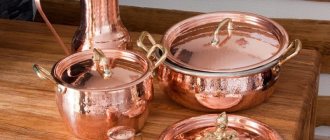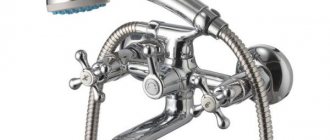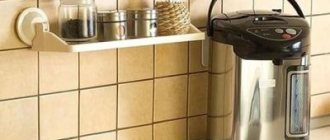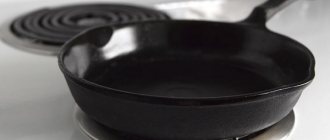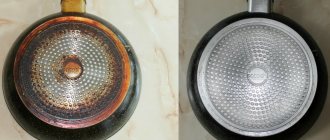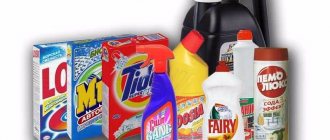( 3 votes, average: 4.00 out of 5)
Constant contact with water contributes to rapid wear of the faucet structure. During use, salt deposits appear on it, in other words, lime deposits. With its education, one has to forget about the original beauty and brilliance of the tap. Such white stains can appear not only outside, but also inside plumbing fixtures. Over time, due to plaque, the crane may no longer turn. It is necessary to take care of the plumbing fixtures in a timely manner so as not to lead to such a state. Moreover, cleaning the faucet yourself will not require much effort or skill.
The moving mechanisms of faucets often become clogged with deposits and begin to leak, make noise, or turn poorly. I will tell you how to disassemble a two-valve type faucet in a bathroom or kitchen and its single-lever version, and also give simple recommendations for cleaning them at home.
You can clean the faucet yourself.
Causes of plaque
Plaque on plumbing appears due to increased water hardness, which is determined by the concentration of mineral salts.
As a rule, calcium and magnesium salts predominate in the water supply. Mixing with soap suds, they leave white marks and streams on surfaces. When the content of iron salts in water is high, a yellow precipitate is formed. But the untidy appearance of the faucet is only an external manifestation of the problem. Limescale deposits are also deposited on the internal surfaces of faucets - after all, there is always a certain amount of water there. In advanced cases, water stone forms on the moving parts of the structure, which disrupts the operation of the taps and can cause them to fail. Moreover, the rate of deposit formation directly depends on the frequency of use of hot water. At temperatures above 70 °C, salts settle much faster, forming scale. This problem is usually typical for boilers and washing machines, but can also affect faucets. Therefore, it is necessary to promptly clean them not only outside, but also inside.
What to do if the faucet is jammed
Sometimes faucets become jammed and stop functioning properly. In this case, two means are used.
Vinegar solution
If the faucet stops working due to salt deposits, you will have to remove it and soak it in a vinegar solution. In this case, the mixture should not be very concentrated. Therefore, vinegar is mixed with water in a ratio of one to three.
This is one of the most effective solvents, used not only in everyday life, but also in industry. In order for the faucet to work, you will have to spray all the places where a lot of salt deposits have accumulated.
Folk remedies
In the age of household chemicals, many have forgotten about cleaning with folk remedies or did not know that there are safer options for how to get rid of plaque so that the surfaces in the bathroom shine not only from the outside, but also from the inside.
You can remove white mineral deposits at home without using professional products.
How to clean plumbing?
To remove plaque, use soda, vinegar, laundry soap and citric acid. These are the safest products and do not create toxic fumes.
Vinegar solution
Acetic acid can easily deal with even old lime deposits. There are two ways to use this substance to clean plumbing:
- Table vinegar (9%!) is mixed with water in a 1:1 ratio. Using a sponge soaked in the prepared solution, treat the area of contamination and after 5-10 minutes wash off with clean water.
- Vinegar is mixed with water in a 1:1 ratio and heated slightly. Soak a napkin in warm acetic acid and wrap it around the tap. After half an hour, you can remove the napkin and rinse the area with water.
If unscrewing the tap is not difficult, it is better to immerse it entirely in a vessel with a solution of acetic acid for 8-10 hours. After this, all that remains is to rinse the part under running water - and all salt deposits will disappear without a trace.
Baking soda
Dilute baking soda with water to form a thick paste. Using a sponge, apply it to all surfaces that require cleaning and leave for 1 hour. It is important to remember that there is no need to rub in the mixture; baking soda will already soften soap and lime deposits quite well. After an hour, carefully remove the remaining pulp. If there are whitish spots left here and there, lightly rub them with the hard side of a dish sponge, rinse the mixer with water and wipe dry.
Salt
Wet salt will clean your bathroom faucet well. In addition, it will not only dissolve the white limescale streaks, but also restore the plumbing fixtures to their former shine. Use salt in the form of a wet paste applied to a sponge. Use it to wipe the stained areas and leave for 30 minutes. Wash off with a damp cloth soaked in warm water and rub with a dry cloth.
Laundry soap
A soap solution is suitable if the calcium deposit has not yet hardened. In addition, laundry soap is an antiseptic and can destroy pathogenic microbes. It will be more convenient to clean the faucet from limescale with soap shavings moistened with hot water to a mushy state. Therefore, the preparation of a cleaning agent consists of 3 stages:
- Grate a handful of laundry soap.
- Moisten it with a little water until you obtain a concentration similar to thick sour cream.
- Add 1 tsp to the solution. baking soda or soda ash.
Moisten a washcloth in the resulting mixture and pour a little more soda, lye or salt on top of it. Rub the mixture thoroughly into the areas where salts are deposited. Leave it to act on lime deposits. After an hour, when the water stone has softened, it is removed by scrubbing. After this, you need to wash off the remaining soap solution with clean water and a rag. Then the mixer is cleaned with a dry cloth.
Lemon acid
Dry citric acid can remove limescale from a faucet no less effectively than fresh lemon. It must be dissolved so that dry abrasive particles cannot harm the chrome plating of the equipment in the shower. Concentrated acid will dissolve calcium deposits and they will become crumbly.
The procedure includes the following steps:
- pour a sachet of citric acid into a small container;
- moisten the powder by adding a few drops of water;
- mix everything until you get a homogeneous porridge.
Apply the resulting product to the areas where calcium salt has formed and leave it until completely dry. Wash the plumbing fixtures with clean warm water and wipe them dry.
Half a lemon will help remove limescale from your bathroom faucet, as it also contains a lot of acid. The resulting sediment is rubbed with pulp and the procedure is suspended until it dries. If the area of contamination is large, then use both halves to wipe off the white sediment from the surface of the mixer. Then clean the softened stone, rinse the tap with clean water and wipe with a dry cloth.
Lemon
Your water tap will be sparkling clean if you clean it with lemon. Cut the lemon and wipe the entire product. Leave it overnight, rinse in the morning and wipe dry.
Citric acid is another affordable product that can clean your faucet well. It can be used to descale your entire bathroom. Apply a little aqueous solution (10 g of acid per ½ liter of water) onto a sponge or cloth and thoroughly clean the surface. This substance causes a disruption in the structure of minerals, ensuring the elimination of scale and limescale. Citric acid works similar to professional scale removers.
Household cleaners
It will be faster and more effective to clean the faucet from limescale using household chemicals. Limestone will come off faster.
Industrial cleaners can be harsh on your hands, so wear gloves.
There are many professional chemicals on the market designed to remove mineral deposits from taps, faucets, sinks and even stoves.
The best ones:
- Top House for stainless steel is an indispensable tool if you properly care for your faucets. This composition not only cleans perfectly, but also protects against the appearance of dirt. Apply the product with several sprays and leave to work for a while if the plaque is heavy. Rinse off with water and wipe the surfaces dry.
- Pufas Glutoclean removes lime and nitrate deposits quickly and easily. The liquid is recommended for use only on surfaces that are resistant to acids. This strong compound can damage faucets made from poor quality materials.
- Selena Shine of Steel - a product designed for metal products. Removes not only mineral deposits, but also fat. Do you want to see your plumbing always shiny? So, choose this composition.
- Ravak Cleaner Chrome is a Czech-made product. It has proven itself well. Cleans faucets, acrylic bathtubs, stained glass showers. The manufacturer indicates that the product is safe. Should be kept away from children.
- SVOD-Effect cares for chrome surfaces. If you want to achieve pristine shine and remove lime and soap deposits, use this professional composition. SVOD-Effect delicately cleanses the most stubborn stains, does not scratch, creates a film that will add shine and protect against the rapid formation of mineral deposits.
- Cif is simply a godsend for housewives. It is applied to surfaces using a sprayer or sponge. Leave on the surface for 10-15 minutes. Sif will get rid of stubborn plaque that other chemicals could not remove.
- Sanox will save any surface from limescale. This product with a unique cleaning formula quickly removes any mineral deposits. Sanox is the cheapest composition among all household chemicals against plaque, but no less effective.
How to clean with home remedies
There are home remedies you can use to clean dirty taps.
Laundry soap
To wash off plaque, they often use ordinary laundry soap, which has a disinfecting effect. Experts advise using 72 percent soap, as it is more effective. To remove contamination, wipe the chrome surface with a soap bar and rinse with warm water.
Many people believe that baking soda only cleans smoke, but this is not true. Soda products effectively combat limescale stains on taps.
To prepare the solution, add 300 grams of soda to a liter of water. Then the composition is stirred until a thick mixture is obtained, which is used to wipe the dirty coating.
Vinegar
To quickly clean taps and remove limescale, use vinegar. It is diluted with water in a ratio of one to two, after which a cloth is soaked in the prepared solution. Then the surface of the plumbing is wiped with liquid. After 10-20 minutes, the tap is wiped with regular water to remove any remaining vinegar.
Lemon acid
When fighting limescale, use citric acid or freshly squeezed juice. Cleaning limescale contamination is carried out in several stages:
- applying acid to a cloth;
- wiping the surface;
- rinsing off any remaining liquid with heated water.
Coca Cola
A popular sweet drink like Coca-Cola will help remove dirty deposits from the surface. An ordinary rag is thoroughly soaked in carbonated liquid, and then placed on a dirty tap. After half an hour, the rag is removed and the surface is washed with water. If traces of plaque remain, the procedure is repeated.
Baby soap
Among non-standard means of removing limescale stains, baby soap is distinguished. Before use, it is diluted in equal proportions with warm water and mixed thoroughly. Then a piece of cloth is soaked in the mixture and used to wipe the tap. After this, it is wiped again with a cloth soaked in plain water.
Toothpicks
Even ordinary toothpicks, which are found in every home, can clean the coating of washbasin taps. To scrape off dirt, carefully grasp the toothpick by both edges with your fingers. Then it is carefully applied to the surface and pulled along it. All salt deposits should be quickly scraped off without the use of additional cleaning products.
It's no secret that salt is an abrasive material, and therefore many believe that it cannot be used to remove limescale stains. However, if used in small quantities, it will help restore the cleanliness of your faucet.
5-8 grams of salt are poured onto a napkin and carefully rubbed into the dirty surface. The treated area is then washed with water.
Baking soda
This is a universal remedy that is used to combat most contaminants. Before cleaning, soda is mixed with water to form a thick paste, which is used to treat the surface with plaque. After 40-60 minutes, the soda is washed off, and the cleaned coating is polished with a dry cloth.
Industrial products
Traditional methods do not always help remove limescale from the tap. Industrial household chemicals eat away salts that have settled after using unfiltered water more strongly. Stores offer a wide range of products for getting rid of lime deposits on plumbing equipment, but not all of them are suitable for cleaning faucets and shower heads from fossilized growths.
The choice of descaling agent depends on several circumstances. Ask the seller a few questions:
- Is the product used for the faucet that is used for cooking and washing dishes?
- Is the solution safe for the human body?
- Are there any aggressive substances that cause harm to the faucet material or darkening of the chrome surface?
- Can chemical reactions produce toxic gases when used?
Please note that potent compounds contain active acids, alkali and chlorine, which negatively affect the surface of chrome-plated products. Liquid products are less toxic than powders and tablets and do not emit toxic gases.
The industry produces 2 types of products intended for the care of plumbing fixtures:
- cleaners;
- polish.
Popular cleaners that have proven themselves to be effective when used in everyday life:
- Top House gel perfectly cleanses salt deposits formed on washbasin taps and shower mixers. A small amount is distributed over the surface and the sediment is removed with a sponge. At the end of the procedure, the tap is washed with clean water and wiped dry.
- Cilit bang helps get rid of calcium deposits and other contaminants on washbasin and bathtub faucets. To prevent the sand from hardening, it is enough to use this cleaning product once a month.
- Sanox is used in the fight against water stone and rust. This product is often used for antiseptic treatment of washbasin taps in toilets and shower rooms in public places.
- Cif spray is evenly applied to the salt deposits of the mixers and then removed along with the loose dirt with a damp rag.
- Ravak Cleaner Chrome will do a good job of removing rough build-up on the faucet if you dilute it with water, apply the mixture to a sponge and wipe the stained areas with it.
- WD-40 removes hardened stone deposits from stuck faucets. The solvent is applied to the salt deposits and washed off with water after half an hour. After which the tap will be easy to disassemble and remove any remaining sand.
Among polishes for chrome surfaces, the following brands enjoy nationwide fame:
- Domax, this product will not only polish the surface to a shine, but will also perfectly restore the shine to tarnished faucets. The gel contains substances that form a protective film. It perfectly repels grease, scale and other contaminants.
- Indesit will restore the shiny surface of the faucet, and will also easily dissolve fat and calcium deposits.
Dismantling the crane
Double valve type
In bathrooms, two-valve faucets are most often used.
Disassembling a bathroom faucet with shower is not particularly difficult:
- We turn off the water. The shut-off valve is usually located near the pipe entry into the apartment, usually in the bathroom;
- Remove the mixer. To do this, use a plumbing wrench to unscrew the nuts that secure the housing to the eccentrics. Care will be required here, as the nuts can crumble with great effort;
- Remove the plugs from the valves. To do this, use a screwdriver or knife to pry up the red and blue circles in the center of the valve handle.
- There is a screw under the plug. We unscrew it and remove the valve from the valve stem;
- We unscrew the faucet axle itself and remove it from the socket in the faucet body.
- We repeat the procedure with the second valve and move on to the shower/gander switch. Here we also take out the plug, unscrew the screw, remove the lever and unscrew the crank (ball, cylindrical mechanism);
- Unscrew the gooseneck from the body. To do this, carefully unscrew the union nut.
- Unscrew the shower hose from the mixer. It is better to do this by hand so as not to damage the chrome layer with a key.
- We remember the disassembly process so that we can put the product back together later.
Once the mixer is disassembled, you can start cleaning it. First you need to remove all the rubber gaskets. This is especially important for older crane axle boxes where the gaskets do not last long
.
If the gasket is dry, cracked, or otherwise damaged, it should be replaced. Before installation, it makes sense to chamfer the gasket
, cutting off the outer corner (on the side where the gasket is adjacent to the mixer body). This will eliminate the noise that old faucets often make.
The new cranes are equipped with a crane axle box with plates. There is no point in disassembling it; the price of a new part does not exceed 250 rubles. just replace the crane axle boxes with new ones
.
We remove the gaskets from all connections and inspect them. If they are cracked, torn, or have lost elasticity, they must be replaced. We unscrew the aerator at the tip of the gander, take out the mesh and gasket. We clean the mesh from plaque, change the gasket (if necessary).
We clean the mixer body from lime deposits and rust.
. To do this, you can use a product like Cillit Bang, Comet, Mr. Muscle or Domestos. Internal surfaces must be clean and smooth.
When unscrewing union nuts and other parts with an adjustable wrench, you should carefully calculate the force, since silumin parts easily crumble and break.
Single lever
Now I will tell you how to disassemble a single-lever faucet in the bathroom. This type of faucet has been used for a long time, and many apartments have just such models installed.
The instructions are slightly different from disassembling a two-valve mixer:
- Before disassembling the single-lever mixer, turn off the water supply. Using a screwdriver, remove the plug from the lever handle;
- Unscrew the screw that secures the lever handle to the cartridge rod;
- Remove the lever handle from the cartridge rod;
- Unscrew the skirt that covers the cartridge;
- Unscrew the nut holding the cartridge;
- We take out the cartridge from the mixer body;
- We remember the disassembly process in order to put the mixer back together.
As with a two-valve faucet, the gaskets should be inspected
. They are located on the bottom of the cartridge. If there are cracks, tears, or the rubber has lost its elasticity, replacement is necessary.
Before disassembling the cartridge, consider replacing it completely. The price of a new product is 200 - 400 rubles. Take the old cartridge with you and ask the seller to give you a similar one.
Cleaning the aerator
Cleaning soap deposits on the outside of the faucet is only half the battle. Modern faucets are equipped with aerators - this is a small metal nozzle with a mesh on the spout of the tap. This small part serves to enrich the water with oxygen and thereby performs a number of useful functions:
- Reduces the noise level of flowing water due to the fact that many small bubbles soften the flow of water.
- Reduces splashing.
- Additional filtration from small debris that occasionally occurs in tap water.
- The aerator helps save water by maintaining good pressure with minimal water consumption. Savings depending on the model can range from 50 to 80%.
It often happens that the aerator becomes clogged with lime flakes and ceases to efficiently cope with its functions. In this case, it needs to be removed and cleaned.
How to understand that it’s time to clean the aerator:
- The tap is fully open, but the water barely flows
- The water flows unevenly, the flow either increases or decreases
- There is water in the system, but it does not pass through the mesh holes
To work, we will need pliers, a rag and a container with detergent.
Carefully wrap the nozzle in a rag, pinch with pliers and turn clockwise. And here the owners of cheap Chinese plumbing fixtures are in for an unpleasant surprise: aerators for such faucets are most often made of extruded aluminum or plastic coated with a shiny coating; both materials are fragile and often break when you try to unscrew them. If the aerator bursts during dismantling, do not despair, buy a new one. High-quality plumbing aerators made of steel or brass last much longer.
If the nozzle is jammed, then use WD-40 or vinegar, wet a cloth, wrap it around the nozzle, wrap it with a plastic bag on top and leave until the mobility of the thread is restored, this is about 2-3 hours.
After you have unscrewed the aerator, rinse it from large contaminants under the running tap, and then place it in a glass with 9% vinegar. The exposure time depends on the degree of contamination and varies from 1 to 12 hours. After the time has expired, rinse the aerator with clean water and, if necessary, clean the holes with a darning needle.
Assemble the clean nozzle and screw it into place; there is no need to tighten it, so you can easily unscrew it with your fingers at any time and wash it. It is advisable to remove and rinse the nozzle once a week, then the aerator will work properly.
Why does plaque appear on taps?
We recommend the product Mixer Imprese Grafiky ZMK041807080
In stock
Equipment: faucet | Material: brass | Type: single lever | Type: mixer | Purpose: for shower |
It is no secret that mineral impurities contained in tap water affect the level of hardness of the aquatic environment and contribute to the formation of limescale deposits on pipeline devices.
To avoid the appearance of limescale, you should follow the simplest rules for operating household plumbing, namely:
- after using the sink or bathtub, you should rinse the tap and wipe it dry;
- wiping the plumbing to remove condensation will help avoid the appearance of dry streaks;
- monthly disinfection of the bathroom will help get rid of fungus and mold on all surfaces.
These simple methods will help you avoid the problems of getting rid of limescale and maintain your health.
How to clean the holes in a shower head?
If the holes of the hydromassage nozzle are clogged, we will use heated vinegar; by the way, vinegar is a universal home remedy that housewives use for various purposes. With its help, you can wash the shower stall from limescale deposits, remove fungus from the bathroom, and even clean the upholstery of furniture from various types of household contaminants.
Unscrew the shower head, disassemble it into parts and soak them in heated vinegar for 1-2 hours, after which, armed with a darning needle, thoroughly clean all the holes and reassemble everything as it was. Instead of vinegar, you can use CilitBang and an old toothbrush. When the limescale is finished, reassemble the watering can and attach it back to the hose.
Wax shampoo
Some housewives have found a way to not only clean the taps, but also protect chrome parts from limescale for a week. To do this, they use waxy car wash shampoo. This product is designed to protect the car body from adverse weather conditions. The wax included in the shampoo forms a thin water-repellent film on the surface, protecting the metal from corrosion. You can buy wax shampoo at any auto store.
Apply a drop of shampoo to the sponge and thoroughly wash all chrome surfaces in the kitchen and bathroom. Polish with a soft cloth or microfiber cloth to a mirror shine. That's all, you can forget about limescale for at least a week.
Restoration of darkened plumbing fixtures
I may disappoint readers, but it is impossible to restore chrome plating at home. However, you can significantly improve the appearance of a faucet damaged by acid or chlorine and partially restore its lost shine. To do this, use polishing paste for chrome car parts, for example: AREXONS Mirage Cromature Brillanti (Italy), Goi paste (made in the USSR) or another similar product. A wide selection of similar products is available in any car store; ask the seller and he will advise you on a suitable polish.
You need to apply the paste to the damaged surface and polish it for a long time with a piece of felt; if you have a sanding machine with a felt attachment in the house, then the work will go much faster. Since the coating is already damaged, this procedure will have to be repeated from time to time.
General rules for cleaning faucets
The chrome surface is easily damaged due to improper mechanical and chemical influences. The following recommendations will help you avoid the formation of defects on the mixer and make work comfortable:
- To remove plaque from chrome plating, it is unacceptable to use any rough materials, such as metal brushes and scrapers, hard sponges and graters. Otherwise, scratches and oxidation of the coating in places of damage are inevitable. Subsequently, further oxidation and contact with water will lead to rust.
- Do not use abrasive substances, products based on chlorine (Domestos, Belizna) and aggressive acids (phosphoric, sulfuric, hydrochloric, as well as concentrated formic and oxalic). They are really great at removing limescale, but they come into contact with metal surfaces, forming black dots and dark spots on them. As a rule, it is impossible to remove such defects. Typically, the instructions on the packaging of such cleaning products indicate the area of use and contain a special warning “Do not use on chrome surfaces.” Therefore, you should not neglect reading this information.
- After removing dirt, the mixer and taps are polished with a cloth - this way the surfaces will remain shiny longer.
- Hard-to-reach areas can be cleaned well with old toothbrushes and kitchen bottle brushes.
- Aluminum foil soaked in water effectively removes rust from a chrome surface. Aluminum reacts with the damaged surface and removes stains.
- The exposure time to cleaning agents, especially professional ones, should not be exceeded.
- When working with vinegar and household chemicals, be sure to thoroughly ventilate the room. Inhalation of acid fumes and other volatile compounds may cause allergic reactions and irritation of the upper respiratory tract.
Features of cleaning enamel baths
Acrylic bathtubs have a perfectly smooth, but prone to damage surface. If handled carelessly, it is easily scratched, and strong concentrated substances can corrode the product. The coating of an acrylic bathtub has no pores, so dirt does not penetrate into it, and cleaning agents are completely washed off with water. But the material is easily painted and can change color: due to rust, acrylic first appears yellow, and then a brown deposit.
Acrylic is not susceptible to corrosion, but it is difficult to wash off old plaque. Entrenched rust can only be removed with aggressive agents that are contraindicated for acrylic surfaces.
The following recommendations will help maintain the integrity of the acrylic coating when cleaning:
- To prevent the detergent from corroding the bathtub, use only special products for acrylic surfaces (there should be information about this on the packaging). For acrylic baths, there are special compositions based on fruit acids.
- Acrylic cannot be cleaned with metal brushes, scrapers or too hard sponges.
- The exposure time of cleaning agents must not be exceeded. Even gentle acidic compounds are best applied for no more than 30 seconds. If it is not possible to remove the plaque immediately, it is better to repeat the treatment after some time rather than overexpose the product and ruin the surface.
- Just in case, it is advisable to test all products on an inconspicuous area.
If you do damage it, here are instructions on how to restore the surface of the bathtub.
Compared to acrylic, cast iron and steel bathtubs are not as sensitive to chemical and mechanical influences. But over time, even on well-groomed enamel, pores appear. If you regularly wash your bathtub with caustic agents, the pores will enlarge and microcracks will form on the surface. Because of this, the bottom and walls of the bathtub become rough and dull.
We suggest you read: How to remove traces of baby urine from a mattress
In general, the rules for washing enamel bathtubs are similar to those for acrylic products, but there are some differences:
- Cleaning agents must be suitable for enamel surfaces. You can also try those designed for acrylic, but they may be weak for enamel.
- Active rubbing with brushes (not metal) and soft abrasives is allowed.
- You should not try to clean or scrape plaque with sharp objects: there is a high probability of breaking off a piece of enamel or severely scratching it.
- It is permissible to treat an old cast-iron bathtub with worn enamel with abrasives and strong acids - this is the only way to wash it to a satisfactory condition. But you need to understand that the unpleasant roughness will not go away, and will only intensify over time. Therefore, it will be more difficult to clean the bathtub every time.
Depending on the situation, you can use folk recipes or household chemicals to remove rust.
Cleaning taps made of precious metals
Plumbing fixtures made of bronze, copper and brass attract with their unusual shine and original appearance. But on such surfaces any dirt and flaws are especially noticeable. These faucets tarnish quickly and require more careful and frequent polishing than chrome faucets. Otherwise, they lose their shine and attractiveness.
There are special household chemicals available for cleaning and polishing faucets made of precious metals. But each type has its own care secrets and improvised means available at home:
- Brass taps are cleaned with a cloth soaked in a soapy solution, a mixture of lemon juice and salt or vinegar and salt. The salt must be well dissolved so as not to scratch the surface. The brass coating “loves” polishing with linseed oil.
- Copper also responds well to cleaning with lemon and salt. But deposits on copper faucets can be removed by boiling in water with the addition of vinegar or dishwashing detergent, after dismantling the structure.
- Bronze faucets are subject to patina. If this effect is undesirable, bronze should also be regularly cleaned and polished with special products or a mixture of water and chicory powder. The mixer, dismantled for cleaning, can be boiled in pea broth.
- For all three types of mixers, cleaning with tomato paste gives a good effect. The applied paste is kept on the surface for up to 30 minutes and washed off with water.
- To polish brass, bronze and copper taps, use professional products, jewelry compounds or GOI paste.
Note: When cleaning and polishing brass, bronze and copper faucets, avoid strong friction with any tools or materials.
Restoration of damaged coating
Darkened chrome steel products can be restored at home using GOI paste, developed by the State Optical Institute for restoring various surfaces. The device is pre-lubricated with machine oil. The paste is applied to a napkin and the darkened surface is carefully polished until the goal is achieved. Please note that the product is not applied to the faucet, but only to a cloth or sponge and then carefully rubbed onto dark spots. Remove excess polishing compound with water.
Rust removal
Getting rid of scale is not the only problem. Even though clean water flows from the tap, its surface may become rusty. This is especially true for iron products that are susceptible to corrosion. How to remove rust stains?
It sounds strange, but the best solution when rust appears is semi-coarse flour. First, degrease the product with warm water and dish gel. Pour flour into a bowl, dip a sponge in water, in flour, wipe the rusty areas. Although at first glance this may seem incredible, in fact, this method is more effective than the similar (but harmful to chrome and nickel) procedure for removing rust with a cleaning powder.
If you still prefer powder, do not use it in its pure (abrasive) form. Place the powder in a bowl and add some water to create a soft paste. Carefully clean the rusty areas and rinse.
Prevention of plaque formation
Home and professional remedies allow you to cope even with old plaque. But the complex shape of faucets and their parts makes the cleaning procedure quite tedious. The need for it will appear much less frequently if you take the following measures:
- Avoid the formation of stubborn dirt and clean the faucet surface regularly.
- Periodically disassemble the faucet and clean the internal parts of the structure, the aerator and the shower head.
- Apply a protective water-repellent layer. Some commercial faucet products are designed to simultaneously clean, polish and create a protective layer on the surface. Finding them is not so easy, and professional solutions are expensive. The easiest way to make an oil coating at home is. For this purpose, cosmetic vegetable oil is recommended, but refined table oil is also suitable. The surface is lubricated with a sponge dipped in oil and then polished with a napkin. This will not prevent plaque from forming, but it will be removed much easier. An oily surface is poorly wetted by water droplets, and most of them will run off the surface. Therefore, overall there will be fewer spots.
- Use a wax-based polish. On construction forums, there are recommendations for the use of wax polishes for chrome coatings of automobile parts. Not a very common option, but there are positive reviews about it. However, before you decide to use such products in a residential area, you should make sure that they are safe: car cosmetics are often toxic.
- Install main water softening filters. Various designs are offered for sale, which differ in operating principle, efficiency and price. There are mechanical, carbon, electromagnetic, ion exchange and reverse osmosis filters for tap water. The most effective are ion exchange and reverse osmosis. But real reviews about their effectiveness are mixed. In addition, the first type requires constant financial costs and significantly increases water consumption. The second type is distinguished by its oversized design, for which it is difficult to find a place in a standard apartment. If you still decide to install such a filter, then, first of all, do a water analysis and determine the ratio of hardness salts to the total amount of salts. This is necessary for correct calculation of installation parameters.
To finally solve the problem with plaque, it is necessary to eliminate its cause. To do this, it is important to prevent the formation of persistent stains and regularly care for the structure. If it is possible to install a high-quality water softening filter, this may be a good solution. With this approach, the surface of taps and mixers will always be shiny, and their operation will be flawless.
Toothpicks
Even they can help in solving the pressing issue related to limescale. Toothpicks are taken by both edges, pressed firmly against the tap and pulled along its surface. This method is relevant only for small salt deposits, as well as for the corresponding pipeline fittings, for example, square taps.
Ideally, you should maintain your faucet daily. Don’t be lazy, and after each opening of the tap, wipe it several times with a regular cloth. If the mixer is constantly dry, then limescale will not appear on it.
The moving mechanisms of faucets often become clogged with deposits and begin to leak, make noise, or turn poorly. I will tell you how to disassemble a two-valve type faucet in a bathroom or kitchen and its single-lever version, and also give simple recommendations for cleaning them at home.
Basic mistakes
There are several mistakes that many people make when cleaning their taps.
Using metal sponge
Some people use very hard sponges made of metal to remove plaque.
However, their use is contraindicated, since after their use scratches and other mechanical damage may remain on the surface. Therefore, it is better to rub the contaminated surface with other products.
Wrong choice of cleaning product
Before cleaning, you need to choose the right cleaning products, as some of them cannot be used.
Abrasive particles
Sometimes cleaning compositions contain abrasive components that can damage the surface of the faucets. Therefore, when choosing a detergent, you need to carefully look at what substances are present in its composition. If there are a lot of abrasive particles in it, you will have to stop using such solutions.
Acids
Some believe that products containing acids are more effective in combating scale. However, such compositions are not suitable for taps and damage their coating. Therefore, to clean contaminants, it is contraindicated to use liquids that contain the following acids:
- phosphorus;
- sulfuric;
- salt.
If you use them, the surface will become covered with dark dots that cannot be washed off.
A mixture of various products
There are times when people mix several detergents at once and use the resulting composition to remove limescale stains. However, the results from using such mixtures may be unexpected and therefore it is better not to use them.
How to clean a bathroom faucet using Coca-Cola
We recommend the product
Mixer Imprese Lesna 55070 2 reviews
To order
Equipment: aerator, faucet | Height, mm: 338 | Material: brass | Type: single lever | Type: mixer | Purpose: for the kitchen |
This is a fairly rarely used method for cleaning bathtub faucets, for example. However, housewives note excellent results from such a simple method. Make a compress with cola and place it on the contaminated area. The acid that is part of the soda will effectively remove plaque and soap stains without leaving any traces on the surface.
Stuck faucet: how to get out of the situation?
When the faucet or mixer switching the water to the shower is not used for a long time, it may jam. The cause of such a breakdown is often a deposit of water stone, which can be dealt with as follows:
- Clean the faucet using one of the above remedies or traditional methods.
- If this method is not suitable, let's turn to another. Take vinegar and dilute it with hot water. Dip the prepared rag into the solution so that it absorbs the product. Wrap a cloth around the jammed faucet, then wrap it in cling film. This is done so that the vinegar does not evaporate, but saturates the plaque deposits well and removes it.
- Another method that any housewife can handle is the use of universal WD-40. It can be used to fix many problems, and a stuck faucet is no exception. Spray the joint between the tap and the mixer with the product and wait a while. The substance can be purchased at any hardware or automotive store.
If the proposed methods do not help open the tap, you will have to call a plumber. In the future, to prevent such situations, promptly clean the gaps in the taps.
Sources
- https://MasteraVannoy.ru/problemy/chem-i-kak-pochistit-krany.html
- https://domovodstvo.pro/uborka/kak-ubrat-izvestkovyj-nalet-s-krana/
- https://bb22.ru/uborka/chem-i-kak-ochistit-kran-ot-izvestkovogo-naleta-v-domashnih/
- https://uborka-v-dome.ru/pravila-chistki/kak-pochistit-kran-ot-izvestkovogo-naleta.html
- https://chistyulka.ru/uhod/kak-ochistit-kran-ot-izvestkovogo-naleta-v-domashnih-usloviyah
- https://hozzi.ru/chistka/kak-ubrat-izvestkovyj-nalet-s-krana
- https://sovremennoedomovodstvo.ru/lifehack/krany-ot-izvestkovogo-nalyota/
- https://sovetchiki.org/1147103638685223076/kak-ochistit-krany-i-santehniku-ot-izvestkovogo-naleta/

